Scale and Rock Type Dependency of Mórágy Granite Formation in the Aspect of Fracture Density
Abstract
1. Introduction
2. Geological Settings
3. Data and Methods
3.1. Source of Data
3.2. Rock Mass Classification Methods (Q, RMR, GSI)
- -
- uniaxial compressive strength of intact rock;
- -
- the average spacing of natural joints;
- -
- the joint condition, the nature of their filling;
- -
- water flow, water ingress conditions;
- -
- direction, orientation of joints in relation to the direction of tunnel drive
3.3. Defining Fracture Sets
3.4. Calculation of Fracture Densities
4. Results
5. Discussion
6. Conclusions
- The parameters of fracture frequency (RQD and fractal D) do not exhibit strong correlations with rock types; however, distinctions can still be observed. It suggests that due to several deformation events, tectonic deformations controlled the fracture patterns in the Mórágy Granite Formation more than rock types, and the differences between unique fracture patterns of rock types vanished in terms of the fracture network.
- During tunnel face mapping, RQD is calculated after a conventional clustering made by a field geologist or a 3D digital photogrammetry approach. It is affected by subjectivity or generated bias. In most cases, multi-phase tunneling processes can cause duplication in mapping results. Therefore, they can enhance fracture sets by overweighting some of them for tunnel stability.
Author Contributions
Funding
Data Availability Statement
Acknowledgments
Conflicts of Interest
References
- Niu, G.; He, X.; Xu, H.; Dai, S. Development of Rock Classification Systems: A Comprehensive Review with Emphasis on Artificial Intelligence Techniques. Eng 2024, 5, 217–245. [Google Scholar] [CrossRef]
- Saadati, G.; Javankhoshdel, S.; Abad, J.M.N.; Mett, M.; Kontrus, H.; Schneider-Muntau, B. AI-Powered Geotechnics: Enhancing Rock Mass Classification for Safer Engineering Practices. In Rock Mechanics and Rock Engineering; Springer: Berlin/Heidelberg, Germany, 2024; pp. 1–31. [Google Scholar] [CrossRef]
- Chudasama, B.; Ovaskainen, N.; Tamminen, J.; Nordbäck, N.; Engström, J.; Aaltonen, I. Automated mapping of bedrock-fracture traces from UAV-acquired images using U-Net convolutional neural networks. Comput. Geosci. 2024, 182, 105463. [Google Scholar] [CrossRef]
- Li, Y.; Elmo, D. A Critical Discussion on the Use of Discrete Fracture Network Models in Rock Engineering Practice: Why Rock Mass Characterisation Methods can Benefit from Considering Fracture Connectivity. In Rock Mechanics and Rock Engineering; Springer: Berlin/Heidelberg, Germany, 2024. [Google Scholar] [CrossRef]
- Deere, D.U. Technical description of rock cores for engineering purposes. Rock Mech. Engng. Geol. 1964, 1, 17–22. [Google Scholar]
- Deere, D.U.; Deere, D.W. Rock Quality Designation (RQD) After 20 Years; Technical Report; U.S. Army Engineer Waterways Experiment Station: Washington, DC, USA, 1989. [Google Scholar]
- Wang, R.; Elmo, D. Discrete Fracture Network (DFN) as an Effective Tool to Study the Scale Effects of Rock Quality Designation Measurements. Appl. Sci. 2024, 14, 7101. [Google Scholar] [CrossRef]
- Ojeda, P.; Elmo, D.; Rogers, S.; Brzovic, A. Discrete Fracture Network (DFN) Analysis to Quantify the Reliability of Borehole-Derived Volumetric Fracture Intensity. Geosciences 2023, 13, 187. [Google Scholar] [CrossRef]
- Singh, J.; Pradhan, S.P.; Vishal, V.; Singh, M. Characterization of a fractured rock mass using geological strength index: A discrete fracture network approach. Transp. Geotech. 2023, 40, 100984. [Google Scholar] [CrossRef]
- Morelli, G.L. Estimating the Volumetric Fracture Intensity P32 Through a New Analytical Approach. Rock Mech. Rock Eng. 2024, 57, 6085–6103. [Google Scholar] [CrossRef]
- Miyoshi, T.; Elmo, D.; Rogers, S. Influence of data analysis when exploiting DFN model representation in the application of rock mass classification systems. J. Rock Mech. Geotech. Eng. 2018, 10, 1046–1062. [Google Scholar] [CrossRef]
- Erharter, G.H. Rock Mass Structure Characterization Considering Finite and Folded Discontinuities: A Parametric Study. Rock Mech. Rock Eng. 2024, 57, 5229–5249. [Google Scholar] [CrossRef]
- Elmo, D.; Stead, D. The Role of Behavioural Factors and Cognitive Biases in Rock Engineering. Rock Mech. Rock Eng. 2021, 54, 2109–2128. [Google Scholar] [CrossRef]
- Palmstrom, A. Measurements of and correlations between block size and rock quality designation (RQD). Tunn. Undergr. Space Technol. 2005, 20, 362–377. [Google Scholar] [CrossRef]
- Palmström, A. The volumetric joint count—A valuable and simple measure of the degree of rock mass jointing. In Proceedings of 4th International Congress International Association of Engineering Geology; Oxford and IBH Publishing Co.: New Delhi, India, 1982; pp. 221–228. [Google Scholar]
- Rusydy, I.; Al-Huda, N.; Fahmi, M.; Effendi, N. Kinematic Analysis and Rock Mass Classifications for Rock Slope Failure at USAID Highways. Struct. Durab. Health Monit. 2019, 13, 379–398. [Google Scholar] [CrossRef]
- Grenon, M.; Hadjigeorgiou, J. Open Stope Stability Using 3D Joint Networks. Rock Mech. Rock Eng. 2003, 36, 183–208. [Google Scholar] [CrossRef]
- Ding, Q.; Wang, F.; Chen, J.; Wang, M.; Zhang, X. Research on Generalized RQD of Rock Mass Based on 3D Slope Model Established by Digital Close-Range Photogrammetry. Remote Sens. 2022, 14, 2275. [Google Scholar] [CrossRef]
- Plinninger, R.J.; Sommer, P.; Poscher, G. On the role of the Engineering Geologist in the Construction Phase of Challenging Tunnel Projects. In Proceeding of World Tunnel Congress 2017; Pål, J., Bjørn, N., Karl, N., Eds.; Norwegian Tunnelling Society: Oslo, Norway, 2017; ISBN 978-82-92641-40-8. [Google Scholar]
- MTóth, T. Determination of geometric parameters of fracture networks using 1D data. J. Struct. Geol. 2010, 32, 878–885. [Google Scholar]
- Min, K.-B.; Jing, L. Numerical determination of the equivalent elastic compliance tensor for fractured rock masses using the distinct element method. Int. J. Rock Mech. Min. Sci. Géoméch. Abstr. 2003, 40, 795–816. [Google Scholar] [CrossRef]
- Baghbanan, A.; Jing, L. Hydraulic properties of fractured rock masses with correlated fracture length and aperture. Int. J. Rock Mech. Min. Sci. Géoméch. Abstr. 2007, 44, 704–719. [Google Scholar] [CrossRef]
- Zhu, J. Effective aperture and orientation of fractal fracture network. Phys. A Stat. Mech. Its Appl. 2018, 512, 27–37. [Google Scholar] [CrossRef]
- Gottron, D.; Henk, A. Upscaling of fractured rock mass properties—An example comparing Discrete Fracture Network (DFN) modeling and empirical relations based on engineering rock mass classifications. Eng. Geol. 2021, 294, 106382. [Google Scholar] [CrossRef]
- Zoback, M.D. Reservoir Geomechanics; Cambridge University Press: Cambridge, UK, 2010. [Google Scholar]
- Liu, B.; Yan, G.; Ma, Y.; Scheuermann, A. Measurement of In-Situ Flow Rate in Borehole by Heat Pulse Flowmeter: Field-Case Study and Reflection. Geosciences 2023, 13, 146. [Google Scholar] [CrossRef]
- Balla, Z. (Ed.) Annual Report of the Geological Institute of Hungary; Magyar Állami Földtani Intézet (Geological Institute of Hungary): Budapest, Hungary, 2004. [Google Scholar]
- Király, E.; Koroknai, B. The magmatic and metamorphic evolution of the north-eastern part of the Mórágy Block. In Annual Report of the Geological Institute of Hungary; Geological Institute of Hungary: Budapest, Hungary, 2004; pp. 299–310. [Google Scholar]
- Maros, G.; Koroknai, B.; Palotás, K.; Musitz, B.; Füri, J.; Borsody, J.; Kovács-Pálfy, P.; Kónya, P.; Viczián, I.; Balogh, K.; et al. Brittle Fault Zones in the Mórágy Granite (South Transdanubia): New Structural and K-ar Data. In Annual Report of the Geological Institute of Hungary; Magyar Állami Földtani Intézet (Geological Institute of Hungary): Budapest, Hungary, 2009; pp. 91–112. [Google Scholar]
- Maros, G.; Koroknai, B.; Palotás, K.; Fodor, L.; Dudko, A.; Forián-Szabó, M.; Zilahi-Sebess, L.; Bán-Győry, E. Tectonic Analysis and Structural Evolution of the north-eastern Mórágy Block. In Annual Report of the Geological Institute of Hungary; Magyar Állami Földtani Intézet (Geological Institute of Hungary): Budapest, Hungary, 2004; pp. 370–386. [Google Scholar]
- Vásárhelyi, B.; Somodi, G.; Krupa, Á.; Kovács, L. Determining the Geological Strength Index (GSI) using different methods. In Proceedings of the ISRM International Symposium—EUROCK 2016, Ürgüp, Turkey, 29–31 August 2016; pp. 1049–1054. [Google Scholar]
- Maros, G.; Borsody, J.; Füri, J.; Koroknai, B.; Palotás, K.; Rálischné Felgenhauer, E. A Mórágyi-rög ÉK-I Részének Szerkezet-Földtani Értékelése a Töréses Szerkezetekre; Magyar Állami Földtani Intézet (Geological Institute of Hungary): Budapest, Hungary, 2012; p. 121. [Google Scholar]
- Kovács-Pálffy, P.; Földvári, M. Hydrothermal minerals and phenomena in the Mórágy Granite Formation. In Annual Report of the Geological Institute of Hungary 2003; Magyar Állami Földtani Intézet (Geological Institute of Hungary): Budapest, Hungary, 2004; pp. 327–338. [Google Scholar]
- Benedek, K.; Molnár, P. Combining structural and hydrogeological data: Conceptualization of a fracture system. Eng. Geol. 2013, 163, 1–10. [Google Scholar] [CrossRef]
- Bíró, L.; Benedek, K. A Repedések Hosszeloszlásának Vizsgálata; RHK-K-092/10; Radioaktív Hulladékokat Kezelő (RHK) Kft: Paks, Hungar, 2010. [Google Scholar]
- Benedek, K.; Bőthi, Z.; Mező, G.; Molnár, P. Compartmented flow at the Bátaapáti site in Hungary. Hydrogeol. J. 2009, 17, 1219–1232. [Google Scholar] [CrossRef]
- Kovács, L.; Kádár, B.; Krupa, Á.; Mészáros, E.; Pöszmet, T.; Rátkai, O.; Somodi, G.; Amigyáné dr Reisz, K.; Vásárhelyi, B. The revision and upgrade of Geotechnical Interpretative Report; RHKK-028/16; Radioaktív Hulladékokat Kezelő (RHK) Kft: Paks, Hungar, 2016. (In Hungarian) [Google Scholar]
- Pötsch, M.; Schubert, W.; Gaich, A. Application of metric 3D images of rock faces for the determination of the response of rock slopes to excavation. In Proceedings of the ISRM International Symposium—EUROCK 2005, Brno, Czech Republic, 18–20 May 2005; pp. 489–497. [Google Scholar]
- Deák, F.; Kovács, L.; Vásárhelyi, B. Geotechnical rock mass documentation in the Bátaapáti radioactive waste repository. Cent. Eur. Geol. 2014, 57, 197–211. [Google Scholar] [CrossRef]
- Zhang, L. Determination and applications ofrock quality designation (RQD). J. Rock Mech. Geotech. Eng. 2016, 8, 389–397. [Google Scholar] [CrossRef]
- Kamera, R.; Vásárhelyi, B.; Kovács, L.; M Tóth, T. Relationship Between the Fractal Dimension and the Rock Mass Classification Parameters in the Bátaapáti Radioactive Waste Repository. In Engineering Geology for Society and Territory—Volume 6; Springer: Berlin/Heidelberg, Germany, 2015. [Google Scholar] [CrossRef]
- Barton, N.; Lien, R.; Lunde, J. Engineering classification of rock masses for the design of tunnel support. Rock Mech. Rock Eng. 1974, 6, 189–236. [Google Scholar] [CrossRef]
- Barton, N.; Grimstad, E. Forty Years with the Q-System in Norway and Abroad; Norsk Fjellteknisk Forening (NFTF): Oslo, Norway, 2014; pp. 4.1–4.25. [Google Scholar]
- Bieniawski, Z. Engineering classification of jointed rock masses. Civ. Eng. S. Afr. 1973, 15, 333–343. [Google Scholar]
- Bieniawski, Z.T. Rock mass classification in rock engineering. In Proceedings of the Symposium Proceedings of Exploration for Rock Engineering, Cape Town, South Africa, 1–5 November 1976; Bieniawski, Z.T., Ed.; Volume 1, pp. 97–106. [Google Scholar]
- Bieniawski, Z.T. Engineering Rock Mass Classifications: A Complete Manual for Engineers and Geologists in Mining, Civil, and Petroleum Engineering; Wiley: New York, NY, USA, 1989; 251p. [Google Scholar]
- Hoek, E.; Kaiser, P.K.; Bawden, W.F. Support of Underground Excavations in Hard Rock, 1st ed.; AA Balkema Publishers: Rotterdam, The Netherlands, 1995; 215p. [Google Scholar]
- Hoek, E.; Carranza-Torres, C.; Corkum, B. Hoek-Brown Failure Criterion—2002 Edition. In Proceedings of the 5th North American Rock Mechanics Symposium, Toronto, ON, Canada, 7–10 July 2002; pp. 267–271. [Google Scholar]
- Barton, N.; Choubey, V. The shear strength of rock joints in theory and practice. Rock Mech. Rock Eng. 1977, 10, 1–54. [Google Scholar] [CrossRef]
- Barton, N. Shear strength criteria for rock, rock joints, rockfill and rock masses: Problems and some solutions. J. Rock Mech. Geotech. Eng. 2013, 5, 249–261. [Google Scholar] [CrossRef]
- Palmström, A.; Blindheim, O.T.; Broch, E. The Q system—Possibilities and limitations. In Proceedings of the Norwegian Annual Tunnelling Conference on Fjellsprengningsteknikk/Bergmekanikk/Geoteknikk, Oslo, Norway, November 2002; pp. 41.1–41.38. (In Norwegian). [Google Scholar]
- Barton, C.C.; Larsen, E. Fractal Geometry of Two-Dimensional Fracture Networks at Yucca Mountain, Southwest Nevada. In Fundamentals of Rock Joints: Proceedings of the International Symposium on Fundamentals of Rock Joints; Stephannson, O., Ed.; Centek Publishers: Lulea, Sweden, 1985; pp. 74–84. [Google Scholar]
- La Pointe, P. A method to characterize fracture density and connectivity through fractal geometry. Int. J. Rock Mech. Min. Sci. Géoméch. Abstr. 1988, 25, 421–429. [Google Scholar] [CrossRef]
- Tsuchiya, N.; Nakatsuka, K. A two-dimensional mono-fractal approach to natural fracture networks in rock. Geotherm. Sci. Tech. 1995, 6, 63–82. [Google Scholar]
- Roberts, S.; Sanderson, D.J.; Gumiel, P. Fractal analysis of Sn-W mineralization from central Iberia; insights into the role of fracture connectivity in the formation of an ore deposit. Econ. Geol. 1998, 93, 360–365. [Google Scholar] [CrossRef]
- Mandelbrot, B.B. The Fractal Geometry of Nature; W.H. Freeman and Company: New York, NY, USA, 1983. [Google Scholar]
- Mandelbrot, B.B. Self-affine fractal dimension. Phys. Scr. 1985, 32, 257–260. [Google Scholar] [CrossRef]
- Barton, C.C. Fractal analysis of scaling and spatial clustering of fractures. In Fractals in the Earth Sciences; Barton, C.C., La Pointe, P.R., Eds.; Plenum Press: New York, NY, USA, 1995; p. 168. [Google Scholar]
- Tóth, T.M. Fracture network characterization using 1D and 2D data of the Mórágy Granite body, southern Hungary. J. Struct. Geol. 2018, 113, 176–187. [Google Scholar] [CrossRef]
- Tóth, M.; Kamera, R. 2010: Repedésrendszer Tulajdonságainak Elemzésére és a Vizsgált Paraméterek Térbeli Kiterjesztésére Alkalmazható Eljárás Kidolgozása, Ellenőrzése és Optimalizálása; RHK−K−103/10; Kőmérő Kft & RHK Kft: Paks, Hungary, 2009. [Google Scholar]
- Szebényi, G.; Török, P.; Hámos, G.; András, E.; Szamos, I.; Miskolczi, R.; Gulácsi, Z.; Maros Gy Mező Gy Korpai, F.; Kovács, L. Földtani Összefoglaló Jelentés. NRHT Létesítés 2008–2012; RHK-K-020/12; Kőmérő Kft & RHK Kft: Paks, Hungary, 2012. [Google Scholar]
- Geiger, J.; Kovács, L.; Deák, F.; Somodi, G. A Bátaapáti Kőzetmechanikai Mérések Matematikai Statisztikai Feldolgozása; RHK−K−077/09; Kőmérő Kft & RHK Kft: Paks, Hungary, 2009. [Google Scholar]


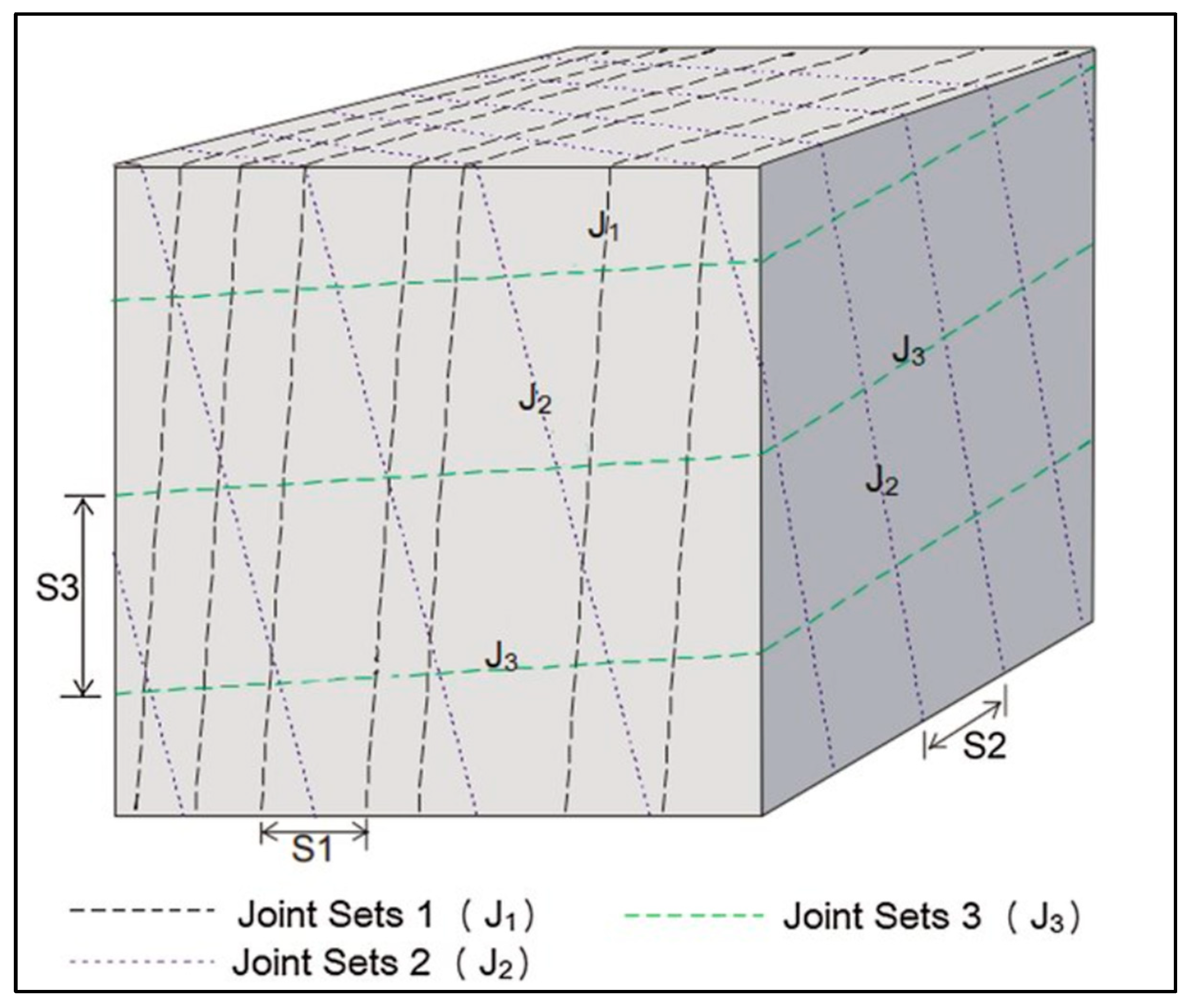
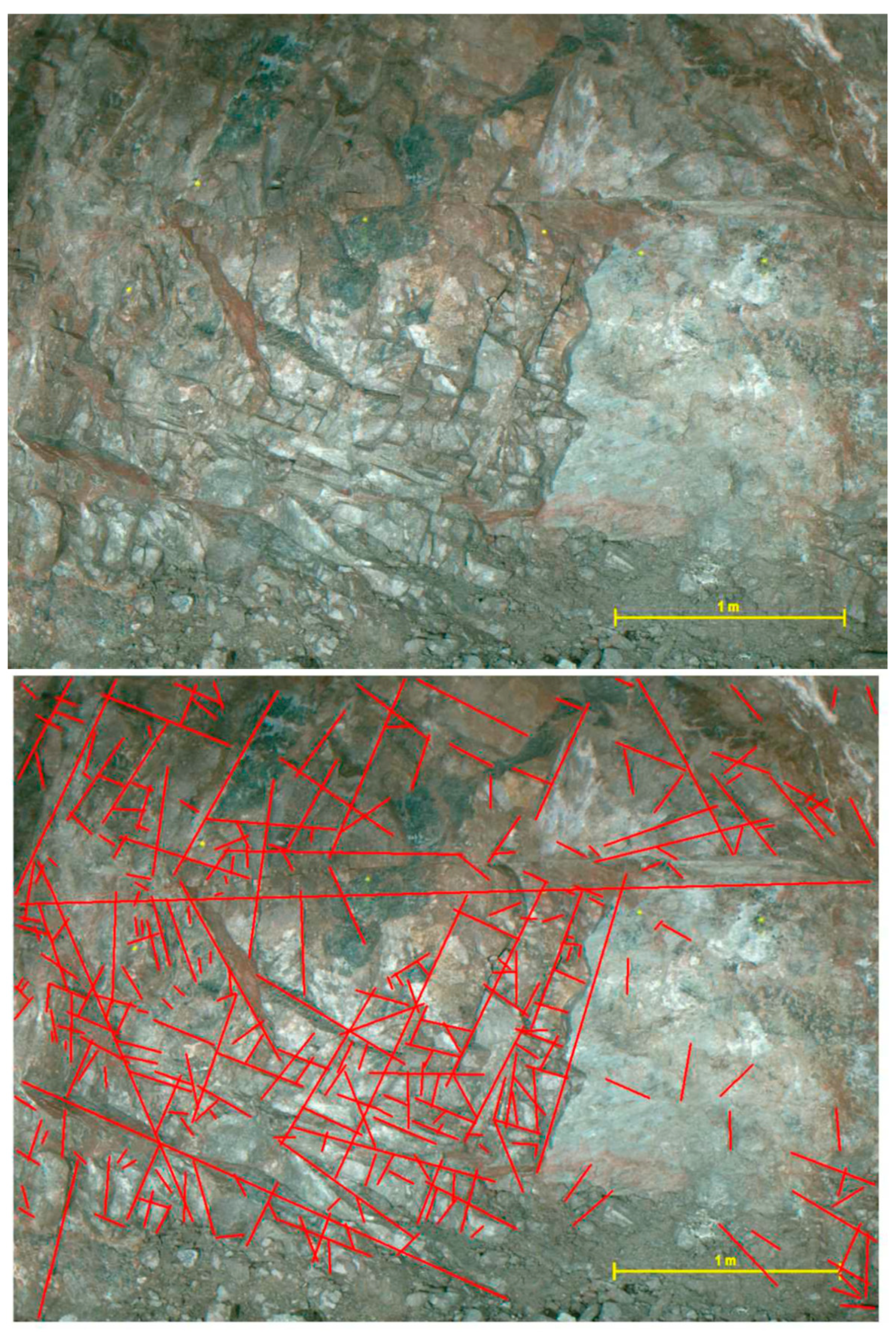
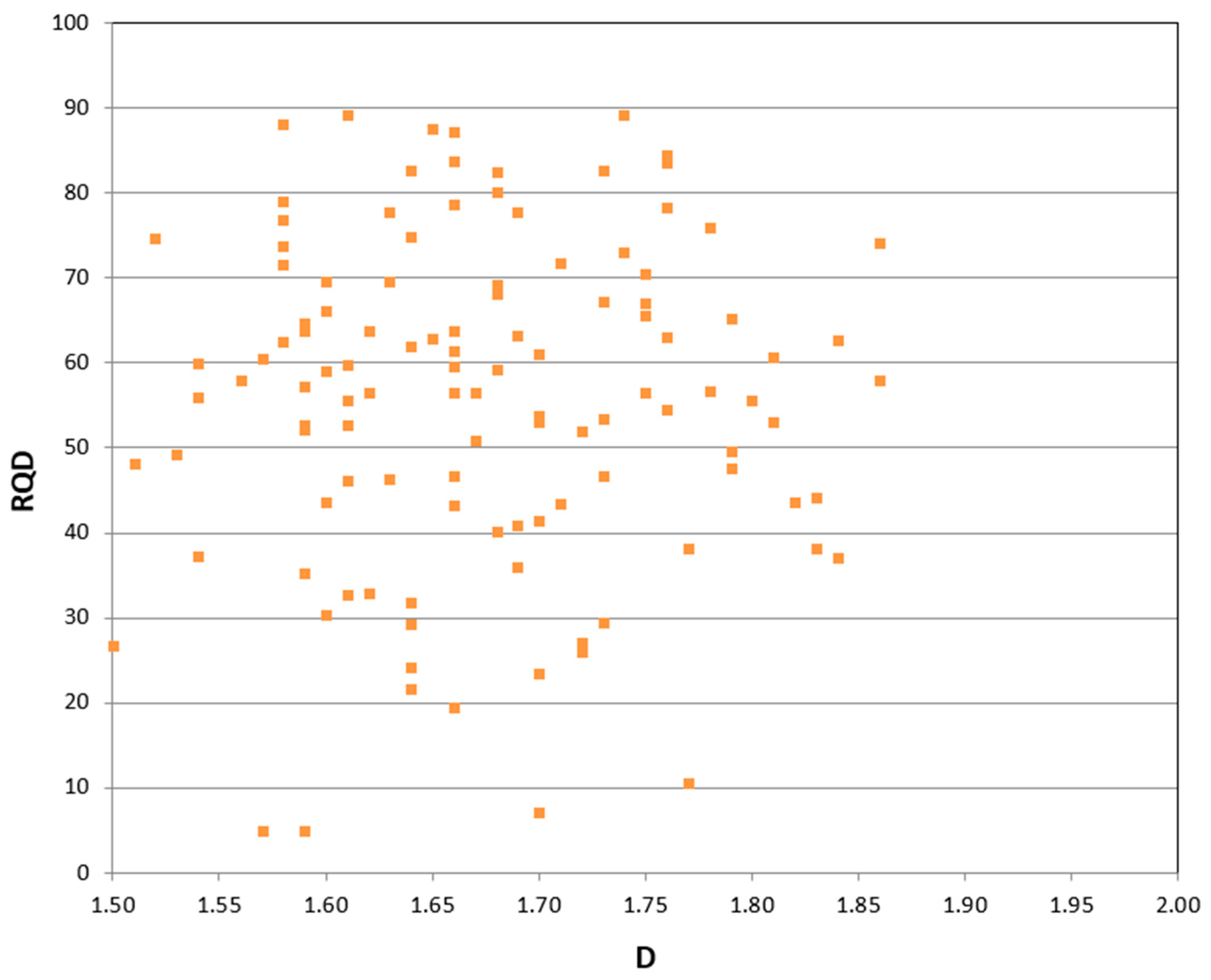
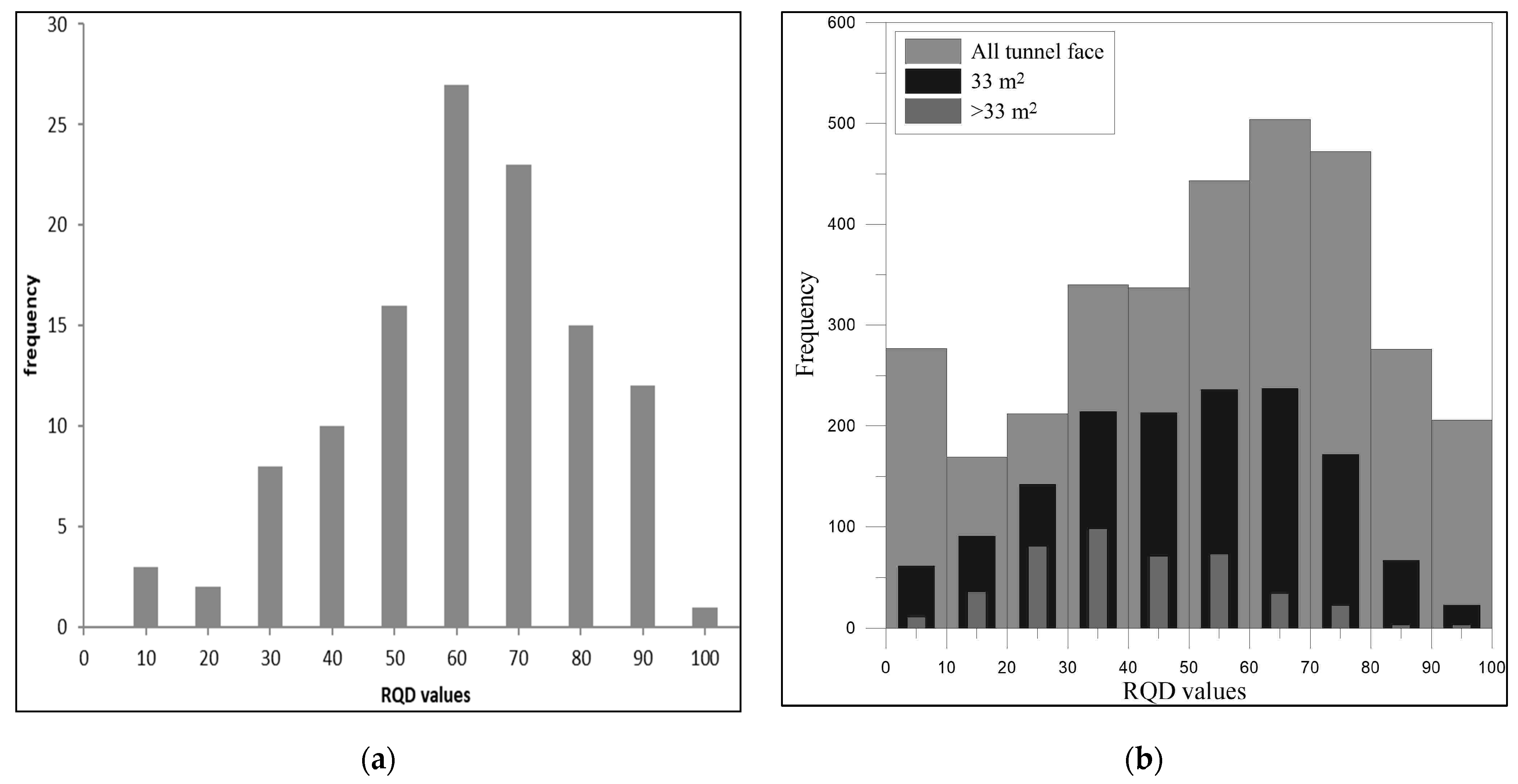
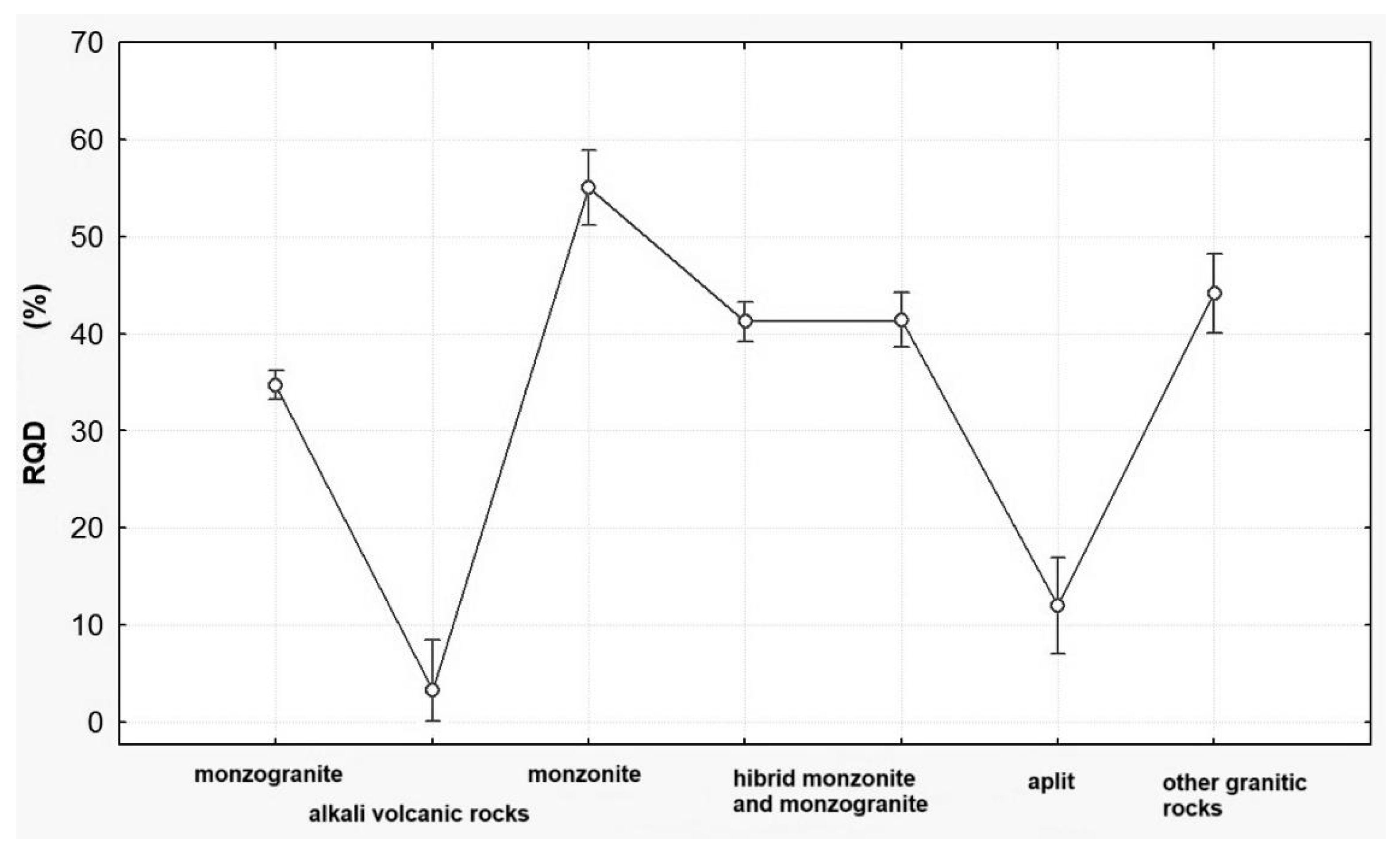
| Monzogranite | Monzonite | Hybrid Rocks | |
|---|---|---|---|
| Number of samples | 59 | 17 | 41 |
| Average | 57 | 54 | 55 |
| Std deviation | 19 | 20.75 | 18.65 |
| Var. Coefficient | 34 | 38 | 34.1 |
| Minimum | 5 | 11 | 7 |
| Maximum | 98 | 89 | 89 |
| Monzogranite | Monzonite | Hybrid Rocks | |
|---|---|---|---|
| Number of samples | 59 | 13 | 55 |
| Average | 1.68 | 1.73 | 1.66 |
| Std deviation | 0.07 | 0.10 | 0.08 |
| Var. Coefficient | 4.5 | 5.6 | 4.9 |
| Minimum | 1.53 | 1.51 | 1.50 |
| Maximum | 1.86 | 1.86 | 1.84 |
Disclaimer/Publisher’s Note: The statements, opinions and data contained in all publications are solely those of the individual author(s) and contributor(s) and not of MDPI and/or the editor(s). MDPI and/or the editor(s) disclaim responsibility for any injury to people or property resulting from any ideas, methods, instructions or products referred to in the content. |
© 2025 by the authors. Licensee MDPI, Basel, Switzerland. This article is an open access article distributed under the terms and conditions of the Creative Commons Attribution (CC BY) license (https://creativecommons.org/licenses/by/4.0/).
Share and Cite
Somodi, G.; Vásárhelyi, B. Scale and Rock Type Dependency of Mórágy Granite Formation in the Aspect of Fracture Density. Geotechnics 2025, 5, 34. https://doi.org/10.3390/geotechnics5020034
Somodi G, Vásárhelyi B. Scale and Rock Type Dependency of Mórágy Granite Formation in the Aspect of Fracture Density. Geotechnics. 2025; 5(2):34. https://doi.org/10.3390/geotechnics5020034
Chicago/Turabian StyleSomodi, Gábor, and Balázs Vásárhelyi. 2025. "Scale and Rock Type Dependency of Mórágy Granite Formation in the Aspect of Fracture Density" Geotechnics 5, no. 2: 34. https://doi.org/10.3390/geotechnics5020034
APA StyleSomodi, G., & Vásárhelyi, B. (2025). Scale and Rock Type Dependency of Mórágy Granite Formation in the Aspect of Fracture Density. Geotechnics, 5(2), 34. https://doi.org/10.3390/geotechnics5020034







